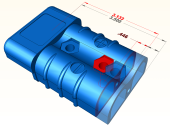 This is an article written by John Groener of Edge Data. He is a reseller of both AutoDesk and Kubotek CAD software. I hope you enjoy his perspective and find it informative and educational. His contact information follows.
This is an article written by John Groener of Edge Data. He is a reseller of both AutoDesk and Kubotek CAD software. I hope you enjoy his perspective and find it informative and educational. His contact information follows.
Direct Versus History-Based Modeling
In 1985 History-Based Modeling was implemented in Pro/Engineer® and quickly imitated by several "Me-Too" CAD products such as CATIA®, SDRC IDEAS®, and UniGraphics®. Then came the "Mini-Me-Toos" such as SolidEdge®, SolidWorks®, IronCAD®, and Inventor®.
History-Based modelers require the CAD user to define parameters and constraints when designing a part. The parameters provide relationships to other features in the 3D part, and constraints allow that part to be constructed unambigously.These parameters, features, and constraints are stored in the order they were built in the history tree and must be accessed through that tree to be changed.
History-Based Modelers have shortcomings.
• Engineering changes can be a difficult, painful process. A new user has to decipher and untangle the history tree so that he can make changes.
• Each CAD software package has its own proprietary file format so parts are not easily interchangeable.
• Assemblies can be time consuming to set up and manipulate.
- There is no stand-alone 2D drawing capability.
- Surface models are not easily interchanged with solids.
KeyCreator uses Direct Modeling to create and edit 3D Models. NO user-defined history tree is needed. Why? Because KeyCreator creates the feature tree and KeyCreator allows direct dimension driven editing. In other words parametric, feature-based editing of all geometry.
KeyCreator has Comprehensive 2D drafting. KeyCreator produces complete 2D drawing sheets associated to the 3D model. KeyCreator uses levels (aka layers) to manage 2D information, so 2D drafting can be standaone if desired.
KeyCreator Reads Native CAD Files from other CAD software like Pro/E, Solidworks, Unigraphics, CATIA, Parasolids, ACIS, STEP, IGES. No fixing, no healing, just read it in, edit, and GO! Wait ... how about the parametrics? That's KeyCreator's job. No need to use the import as reference geometry and re-parameterize it. Just go to work.
KeyCreator incorporates surface modeling. With KeyCreator you can create a free-form surface model and then convert it to a solid model to facilitate operations like shelling and fillets. Excellent healing tools insure that the part is completely contiguous and accurate. KeyCreator is therefore a TRUE Hybrid Modeler (a hybrid of solid and surface models).
KeyCreator's assembly modeling features can manage all data in a single file. It does this by using level management - that same invaluable 2D tool which is noticeably absent in the other Solid Modelers. For very large assemblies, KeyCreator can export parts in the assembly to multiple part files and then reference those parts as entities.
KeyCreator is a complete Mechanical CAD solution with a unique ability to read any CAD data format and then easily manipulate geometry, making it an invaluable resource for any engineering design and manufacturing application.
KeyCreator and Edge Data
Did you know that ...
... KeyCreator®, formerly known as CADKey®, was introduced in 1984 as a CAD Package with 3D Digitizing capabilities.
... Kubotek Corporation purchased CADKey in 2003, renamed the software KeyCreator, invested heavily in R&D, added advanced 3D, CAM, and universal CAD translation.
... Edge Data, one of the first AutoCAD dealers in the country, has been providing New England with CAD products and training since 1983?
...Today Edge Data is an Authorized Kubotek Service Center, and provides CAD training for KeyCreator and other software.
Best Regards,
John Groener
Edge Data Corp.
978-537-9800
john@edgedata.com
www.edgedata.com
